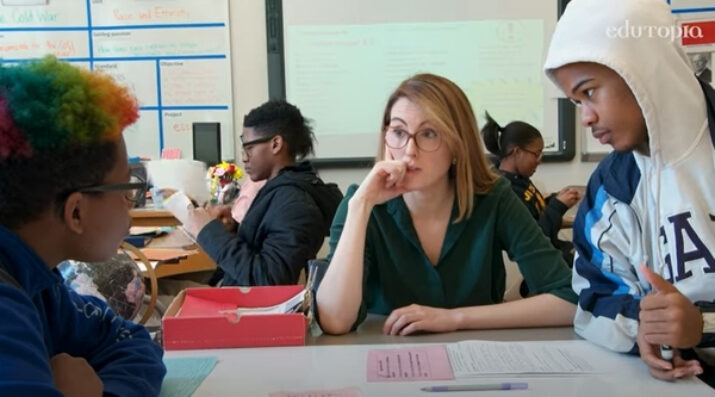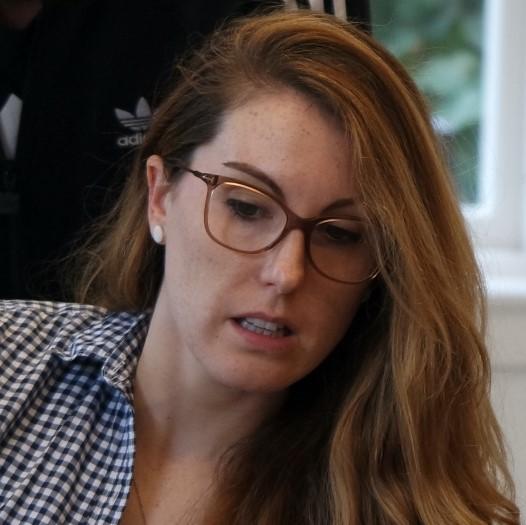Building Resilience after Trauma
Topics

We’ve all had the experience of truly purposeful, authentic learning and know how valuable it is. Educators are taking the best of what we know about learning, student support, effective instruction, and interpersonal skill-building to completely reimagine schools so that students experience that kind of purposeful learning all day, every day.
As educators, we can build classrooms that are grounded in unconditional love and support, but also revision, mastery, and ultimately resilience.
In the summer of 2018, I joined 25 other U.S. high school teachers in studying at Yad Vashem, the World Holocaust Rembrance Center. We spent 10 days exploring the political and social causes of the genocide of Europe’s Jewish population and, often, emotionally, examining the human impacts that this crisis unleashed on the lives of millions. One morning Rena Quint sat amongst us: she was 83, a grandmother many times over, a regular volunteer at the museum, and a former teacher. She was also a survivor of the cataclysmic historic event we were studying. Soon after her mother and two older brothers were murdered at the Treblinka extermination center, she and her father were deported to a concentration camp. Rena was seven. After her father’s murder, she was sent to Bergen-Belsen, the notoriously dangerous, disease-ridden camp where Anne Frank passed away of typhus. When the Allies liberated Rena at Bergen-Belsen in 1945, she was 10 years old. This would-be fifth grader had survived physical and emotional abuse, witnessed numerous acts of violence, endured neglect, fought severe malnutrition, and suffered the unthinkable losses of multiple loved ones, community, and all normalcy. I’d had the privilege of hearing Holocaust survivors speak before, but, when we sit back and truly listen, it’s stunning to think about how a young person survived trauma like this, even after the guns of war cease and the buildings of concentration camps are demolished.
Teachers are deeply familiar with the devastating toll trauma takes on the minds and bodies of young people. Every day, when we stand back and look behind a student’s lack of self-regulation and seeming persistent “high alert” status, we are heartbroken when we imagine the circumstances that caused these coping behaviors to develop. We’re also gravely worried about the academic and social future this child, statistically, could face.
When I looked at Rena, I wanted to know, realistically, how this woman—a kind, functioning, resilient person—was in front of me after so much childhood trauma. I wanted to know what I could do, as an educator, to foster resilience in my students, especially those who had endured multiple and chronic adverse childhood experiences.
I asked her, directly, “When you reflect on your life after 1945 and the people who helped you become resilient, what would you say a child needs from their teacher to begin to overcome trauma?” She paused, and then in one breath, thoughtfully said, “They need love and support, unconditionally. And once they are safe, they need someone to push them. They can’t stay where they are. They need to know that you will push them.”
I reflected on how I had honed in on the first part of Rena’s statement: loving my students unconditionally. This was a message I was used to hearing and embraced wholeheartedly. But I began to think about her second point. I thought of all the times I hadn’t pushed kids. I was a “good” teacher, even a “highly effective” teacher many times over, according to Washington, D.C. Public Schools. But my classroom was built on compliance and completion, not mastery. I taught everyone the same lesson on the same day and expected students to grasp material, even if they’d missed the previous lesson. I accepted below-standard work, and revision only happened if a motivated student wanted to re-do an assignment after school for a higher grade. I ushered the entire class onto new material before I had given everyone a fair shot to truly master skills and concepts. In a subtle but pernicious way, I had given up on many of my students because I wasn’t truly requiring each student to show me and, most importantly, themselves that they can understand and master material. I had, as Rena might say, left them where they were, both emotionally and academically.
In my traditional classroom, I had neglected the fact that to build resilience, students need to manage and master difficulties, including academic content. Too often, it’s the students who have endured significant trauma who, by high school, have lost hope and are afraid of even trying… because trying could lead to failing… and failing is not safe. These students need love and support, but they also need to know there is an adult who cares enough about them to hold them to making academic progress. I began to understand that to build their resilience, I needed to not merely laud “grit;” I needed to build a classroom ecosystem that gave students an opportunity to safely try, revise, and ultimately master.
As any teacher will tell you, I knew this mastery would not happen at the same time and at the same pace for everyone. Thus, a mastery-based classroom must be an environment where students can develop true understanding at their own pace. But how could I actually do this? To me, “mastery-based” and “self-paced” learning sounded like a quixotic confluence of 1) education buzzwords that lined the pockets of the latest-and-greatest for-profit pop-education speaker, and 2) a pipe-dream that could only manifest in elite schools where every student read at grade level and enjoyed a safe, loving childhood. I was a tired teacher in a Title I school with below average in-seat attendance and who served a student body impacted by systemic racism and inequity. Yes, I craved the ability to work with students one-on-one or in small groups, to offer immediate feedback and remediation. I desperately wanted to hit the pause button for some kids to say, “Let’s try this again: let’s review our notes, re-read this passage, and revise.” But how? I had no realistic framework of how to do this in a high school history classroom of 25+ students, whose SRI levels ranged from fourth to twelfth grade.
I was fortunate that other teachers at my school had been reflecting on this, innovating instruction in their own classrooms, and codifying what worked into the tenets that now guide the Modern Classrooms Project, a nonprofit organization two teachers at my school founded and grew into a movement that has now served thousand of educators globally. With the passion, optimism, and realism that seem to exist in all teachers, I worked with my colleagues to reimagine my classroom to be a self-paced, mastery-based environment where students accessed my instruction through videos I made for them. This use of instructional videos freed me up to work with students directly: to pull a kid who read below grade level to review a text with me, to direct my high-fliers to resources where they could research topics deeper, and to have one-on-one, human conversations with my students who were disengaged or distressed. Students could advance through a unit of study at their own pace, going on to Lesson 2 only when they had shown they mastered Lesson 1. This often occurred after making revisions, which was celebrated. While a difficult concept for many students—especially those who fear failure—to internalize initially, revision became commonplace and an accepted aspect of learning.
Our students will approach confidence when we tell them they can do it, but they will begin to build resilience only once they see they can—and we expect them to—try, revise, and master. As Rena might say, we can’t leave our students where they are, especially those who’ve survived trauma. As educators, we can build classrooms that go beyond platitudes of “focus” and posters that praise “hard work;” we can build classrooms that are grounded in unconditional love and support, but also revision, mastery, and ultimately resilience.
Image at top: the author with two students, a screenshot from A Student-Centered Model of Blended Learning, a video by Edutopia.




